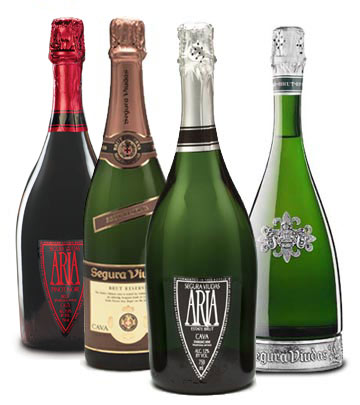 Ever heard of Cristalino? What about Freixenet? These are just two Spanish bubbly offerings on the market, known as Cava, that come in under $10 at your local shop. The thing about Cava is it's not just cheap - it's tasty, too!
Here are a few fun facts to get our conversation rolling today...
Ever heard of Cristalino? What about Freixenet? These are just two Spanish bubbly offerings on the market, known as Cava, that come in under $10 at your local shop. The thing about Cava is it's not just cheap - it's tasty, too!
Here are a few fun facts to get our conversation rolling today...
- Cava means cave, or cellar, in Catalan;
- More than 220 million bottles are sold each year;
- Four stars beneath the cork indicate it's D.O. authenticity;
- 95% of all Cava (and the best on offer) comes from Northern Spain's Penedes region;
- By law, any one (or blend) of five white grapes are permitted in Cava. The three most common are Macabeo, Parellada, and Xarello, with Chardonnay and Subrait (Malvasia) used on occasion.
- Less than 1% of all Cava is rose (in which case either Cabernet Sauvignon, Garnacha or Monastrell grapes are employed).
- And, the traditional method, or Methode Champenoise as we've already discussed, is used to create its lovely little bubbles!
Cava came into being in 1872 when Don Jose Raventos (head of bodega Codorniu) found himself tromping through Champagne, France and encountered their specialty for the first time. He was fascinated and became determined to produce a Spanish bubbly. But I find it delightfully refreshing Cava does not try to play second fiddle to its famous international counterpart. No, Sir!
For starters, the Penedes region is geographically and climatically very different than Champagne. They also use different grapes. Specifically, in Cava they use exclusively WHITE grapes, whereas in Champagne Pinot Noir is one of the 3 permitted varietals (and used often, at that). In Spain, the wine is aged for only 9 months on the lees (the dead yeast cells that give Champagne it's toasty character due to being aged on them for at least 15 months). The differences go on, but the important thing is the result: Cava is less nuanced, offering a simple, cheery, citrusy/fruity, high-acid alternative to Champagne.
For the record, while I have no problem popping a Cava cork for the sake of Cava drinking, I also have to say these wines really do work some additional magic when blended for your holiday brunch mimosa and the like. Their clean flavors (aka, fruity, lesser yeasty quality) don't compete with whatever other ingredients you're throwing together, instead adding a nice bit of lift to the festivities!
Of the three bubblies we've bantered about thus far, which is your preference? Champagne, Prosecco, or Cava?
